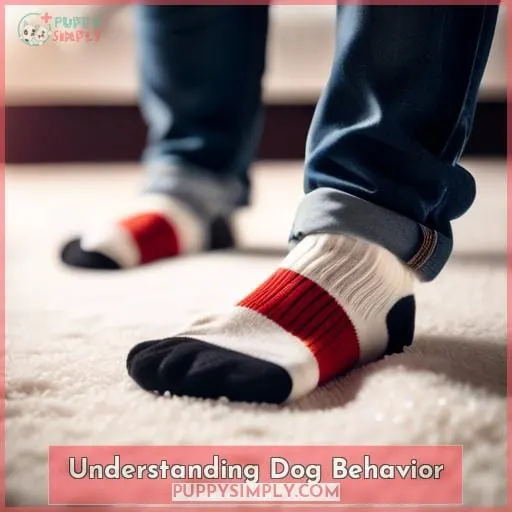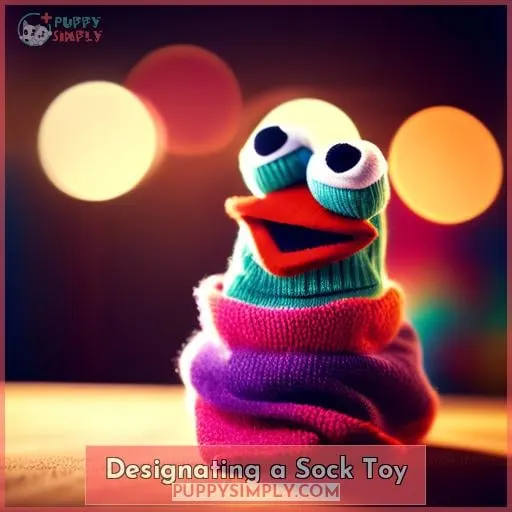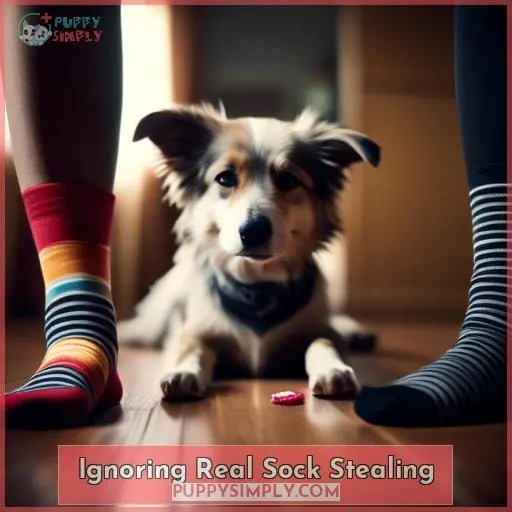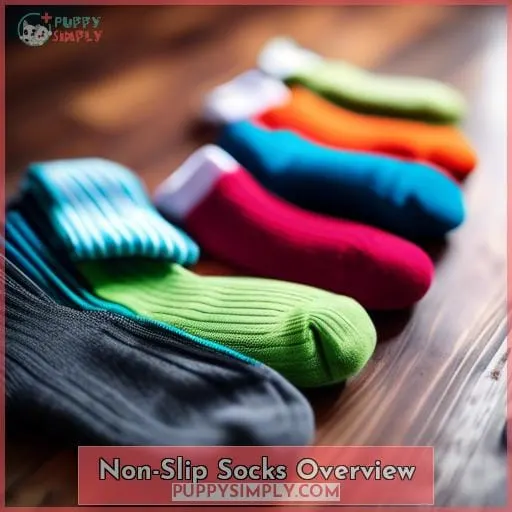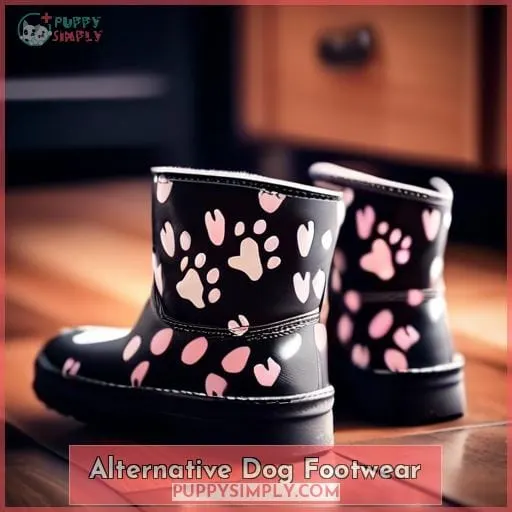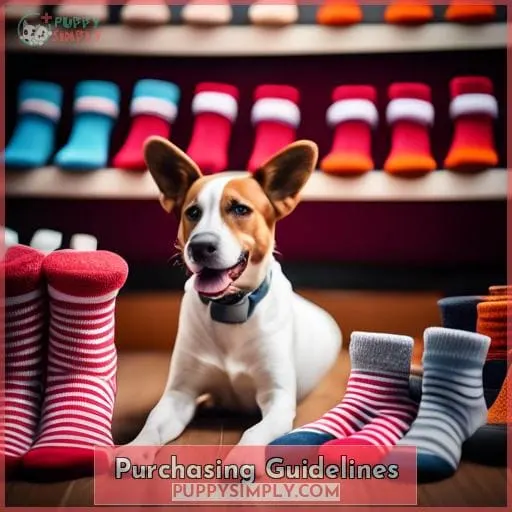This site is supported by our readers. We may earn a commission, at no cost to you, if you purchase through links.

You’re not alone in your quest to find the perfect paw socks for your dog, ensuring both comfort and good conduct.
Whether it’s to prevent your furry friend from turning your socks into toys or to protect their paws, finding the right fit is crucial.
Let’s dive into the essentials of paw protection and behavior management, so you can keep those paws safe and those socks in the drawer!
YES, to buy socks for your dog, look for non-slip options on websites like Amazon, which offer a variety of sizes and styles to protect your dog’s paws and prevent licking. Choose the right size for a snug fit and consider features like grip and durability for both indoor and outdoor use.
Table Of Contents
- Key Takeaways
- Understanding Dog Behavior
- Designating a Sock Toy
- Ignoring Real Sock Stealing
- Reinforcing Good Behavior
- Patience and Consistency
- Non-Slip Socks Overview
- Alternative Dog Footwear
- Purchasing Guidelines
- Frequently Asked Questions (FAQs)
- How can I measure my dog’s paw size accurately to ensure the socks fit properly?
- Are there any hypoallergenic materials used in dog socks for pets with sensitive skin?
- Can dog socks be used to help with healing after a paw injury or surgery?
- How do I introduce my dog to wearing socks without causing them discomfort or anxiety?
- What is the best way to clean and maintain dog socks to ensure their longevity and effectiveness?
- Conclusion
Key Takeaways
- Choose Socks for Protection and Comfort: Select socks that offer protection from harsh weather conditions, such as hot pavements in summer and icy surfaces in winter. Look for materials that provide both durability and comfort to ensure your dog’s paws are well-protected against various outdoor elements.
- Consider Your Dog’s Needs and Breed: Research your dog’s breed to understand their specific needs regarding paw protection. Some breeds may require more protection due to their size, the climate they live in, or their activity level. This research will help you choose socks that best suit your dog’s individual needs.
- Ensure Proper Fit and Functionality: Make sure the socks you choose fit your dog properly to prevent them from slipping off during use. Look for socks with features like non-slip soles for improved traction, especially for older dogs or those with balance issues. Proper fit also includes selecting socks that are easy for your dog to get used to and comfortable to wear for extended periods.
- Use Socks as a Training and Positive Reinforcement Tool: Introduce socks to your dog gradually, using positive reinforcement to create a pleasant association with wearing them. This can include treats and praise to encourage your dog to wear socks willingly. Additionally, consider socks as part of a broader strategy to manage and redirect undesirable behaviors, such as sock-stealing, by providing appropriate alternatives for play and enrichment.
Understanding Dog Behavior
When it comes to understanding dog behavior, especially in relation to socks, it’s crucial to recognize that for dogs, stealing socks often becomes a playful game rather than a mischievous act.
If you’re facing this issue, remember that ignoring the bad behavior is key. By not reacting when your dog steals a real sock, you’re teaching them that this action won’t garner your attention or lead to a fun chase.
Sock Stealing as a Game
Your dog’s sock-stealing antics are actually a cleverly invented game of keep-away, where your attention is the ultimate prize.
This stealing game taps into their instinct for attention seeking and can become an addictive behavior if not managed.
To curb this inappropriate play, which often stems from a boredom issue, introduce dog socks for designated play and teach the drop command.
Importance of Ignoring Bad Behavior
Continuing from the previous discussion on sock stealing as a playful act for dogs, it’s crucial to understand that ignoring your dog’s misbehavior is a key strategy in discouraging this unwanted activity.
By not reacting, you avoid giving consequences for misbehavior, encouraging alternate attention-seeking behaviors.
Instead, focus on rewarding good behavior, training with consistency, and providing enrichment toys like dog socks for paw protection, aligning with behavior tips.
Designating a Sock Toy
When choosing a sock for your dog’s toy, it’s crucial to pick one that stands out from your regular socks. This ensures your dog can easily distinguish between what’s a toy and what’s not, making playtime both safe and enjoyable.
By engaging positively with your dog using this designated sock, you reinforce good behavior and strengthen your bond.
Choosing the Right Sock
As you transition from understanding your dog’s behavior to actively engaging with it, find an old sock that you no longer need to create a designated sock toy. This approach not only taps into your dog’s natural play instincts but also channels their energy positively.
When choosing the right sock, consider sock material for durability and comfort. Opt for a color variety to maintain design appeal, ensuring the sock stands out as a special toy. Durability concerns are vital; a sturdy sock withstands rough play. Follow cleaning instructions to keep the toy hygienic.
This method fosters a sense of belonging and safety for your dog, serving their need for attention without encouraging unwanted behavior.
Making Play Positive
Once you’ve selected an old sock that’s no longer in use, transform it into a designated sock toy to encourage positive play with your dog.
Engage in training sessions using distraction techniques like keep away, which provide mental stimulation.
Such dog games, paired with dog socks for safety, nurture a sense of belonging and contribute to their well-being.
Ignoring Real Sock Stealing
In dealing with your dog’s real sock stealing, it’s crucial to ignore the behavior entirely to discourage it. This approach is part of a broader strategy to ensure your furry friend understands what actions are acceptable and which are not.
- Consistently ignore any attempts by your dog to engage you in a game of keep-away with a real sock.
- Introduce dog socks for indoor use to differentiate between their toys and your belongings.
- Establish a paw cleaning routine that includes wearing socks overnight, especially for training older dogs and managing sizes for puppies.
- Reinforce the use of custom dog socks as a positive alternative, making it a fun part of your pet’s daily activities.
Reinforcing Good Behavior
When you’re training your dog to leave your socks alone, it’s crucial to reward them for playing with the right toys.
Make sure they’re getting enough exercise to tire them out and reduce their sock-stealing urges.
Consistently praising your pup when they choose their toys over your socks will reinforce the behavior you want to see.
Rewarding Alternative Actions
By rewarding your dog with treats or praise for choosing toys over socks, you’re reinforcing good behavior and encouraging positive choices.
Engage in regular play sessions, provide boredom solutions with alternative toys, and ensure indoor safety by redirecting focus to designated items.
Rewarding alternative actions helps deter outdoor hazards and promotes a harmonious environment while enjoying the benefits of dog socks or gift socks.
Providing Adequate Exercise
To ensure your dog’s good behavior, you’ll need to provide plenty of exercise. This helps burn off excess energy and reduces boredom-related mischief. Regular walks and playtime can prevent the sociology of sock stealing. A well-exercised dog is less likely to seek entertainment through mischievous acts.
Whether it’s cold weather or hot, dog boots or shoes can protect their paws on rough terrain.
Patience and Consistency
Your perseverance is essential when teaching your dog to stop stealing socks, as this behavior modification won’t happen overnight.
Implementing positive reinforcement and introducing alternative games can significantly aid in this process. Remember, each breed may respond differently, so understanding your dog’s unique needs is crucial for both indoor safety and outdoor adventures.
Dog socks not only offer paw protection but also serve as a tool for behavior management. Consistency in your approach will reinforce the desired behavior, making patience your best ally.
By consistently rewarding your dog for choosing the designated sock toy over real socks, you’re laying the foundation for lasting change. Keep in mind, behavior tips like these are invaluable for creating a harmonious living environment, ensuring both you and your furry friend enjoy a safe, happy life together.
Non-Slip Socks Overview
When considering non-slip socks for your dog, it’s important to assess their effectiveness for large breeds. Understand the appropriate wearing duration to avoid discomfort and be aware of any limitations.
These socks can be a great aid for dogs struggling with slippery floors, but they’re not a one-size-fits-all solution.
Effectiveness for Large Dogs
Considering non-slip socks for your large dog can be a balancing act. They may offer improved stability on smooth surfaces but also come with potential sizing issues and limitations for extended wear.
These socks enhance traction on slippery floors, reducing paw irritation and aiding elderly dog mobility. However, ensure proper fit to avoid discomfort, and consider donating unused pairs to shelter dogs in need.
Wearing Duration and Limitations
When buying non-slip socks for your dog, it’s important to know that they shouldn’t be worn 24/7 and are best used for several hours at a time.
Incorrect boot sizing or ignoring Velcro issues can lead to discomfort.
Overheating risk and peeling decals are concerns, yet these socks offer safety on suitable terrains.
Consider a giftbox for dog photo socks as a special treat.
Alternative Dog Footwear
When considering alternative footwear for your dog, you might want to look into options like Soft Claws, Ultra Paws, or Dr. Buzby’s Toe Grips. These products offer different benefits, such as nail caps without glue or indoor and outdoor boots, providing your furry friend with the necessary traction and paw protection.
It’s essential to choose the right size and type based on your dog’s specific needs and activities.
Soft Claws and Ultra Paws
While you’re exploring options for your dog’s paw protection, Soft Claws and Ultra Paws offer alternative solutions to traditional non-slip socks.
Soft Claws effectiveness lies in their nail caps, which provide traction without glue.
Ultra Paws are known for their durability, even in challenging weather conditions.
Ensure proper sizing to avoid issues and match the footwear to your dog breed’s needs.
Dr. Buzby’s Toe Grips
You’ll find Dr. Buzby’s Toe Grips to be a unique alternative to traditional dog footwear, offering enhanced traction directly on your dog’s nails.
- Allergies: Ideal for dogs with allergies, as they don’t cover the entire paw.
- Durability: Made for long-lasting use, reducing the need for frequent replacements.
- Maintenance: Simple to apply and require minimal upkeep, ensuring your dog’s safety and comfort.
Purchasing Guidelines
When you’re ready to buy socks for your dog, it’s crucial to assess their paw protection needs first.
Consider the sizing and fit carefully to ensure a snug, comfortable fit that won’t slip off during use.
This step is key in finding the right product that offers both protection and comfort for your furry friend.
Assessing Paw Protection Needs
Before selecting the ideal non-slip socks or alternative footwear for your dog, it’s crucial to evaluate their specific paw protection needs based on their daily activities and environment.
Consider the challenges they face, whether it’s indoor slick floors or rough outdoor terrains.
The right paw protection materials can safeguard their paws on different surfaces, ensuring their safety and your peace of mind.
Sizing and Fit Considerations
When selecting socks for your dog, it’s crucial to measure their paws accurately to ensure a snug and comfortable fit.
- Check the sock material for durability and comfort.
- Consider your dog’s paw type and any breed-specific differences.
- Evaluate the longevity of the socks and their ability to withstand your dog’s activities.
- Review the return policy in case the fit isn’t perfect.
Frequently Asked Questions (FAQs)
How can I measure my dog’s paw size accurately to ensure the socks fit properly?
To accurately measure your dog’s paw, press it on a piece of paper, mark the front and back, and measure the distance.
Are there any hypoallergenic materials used in dog socks for pets with sensitive skin?
Yes, hypoallergenic materials are used in dog socks for pets with sensitive skin.
Power Paws dog socks, for example, offer protection from heat, cold, and allergens, making them suitable for dogs with allergies.
They serve as a barrier to allergens and are machine washable, which is crucial for maintaining a hypoallergenic environment for your pet.
Can dog socks be used to help with healing after a paw injury or surgery?
Yes, dog socks can be beneficial for healing after a paw injury or surgery. They protect the wound from dirt and contaminants, keep bandages clean and dry, and aid in the healing process by allowing air to flow around the wound area.
It’s important to choose breathable, lightweight, and possibly waterproof options to ensure comfort and effectiveness.
How do I introduce my dog to wearing socks without causing them discomfort or anxiety?
Introducing socks to your dog is like teaching a fish to walk; start slow.
Let them sniff the socks, then gently put them on, rewarding with treats for calm behavior, ensuring a snug, comfy fit.
What is the best way to clean and maintain dog socks to ensure their longevity and effectiveness?
To clean and maintain dog socks, turn them inside out and wash in a mesh bag on a gentle cycle with cold water.
Air-dry them away from direct sunlight.
Avoid bleach and fabric softeners to preserve the grips.
Conclusion
You’ve navigated the ins and outs of canine comfort and conduct, understanding that the right paw socks can transform behavior and protect your dog’s feet.
When you’re ready to buy socks for your dog, consider their unique needs, ensuring a snug fit for those playful paws.
With the perfect pair, you’ll keep your socks safe and your furry friend happy.

